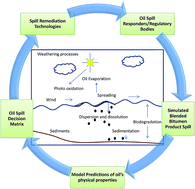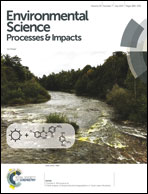An oil spill decision matrix in response to surface spills of various bitumen blends†
Abstract
Canada's production, transport, and sale of diluted bitumen (dilbit) products are expected to increase by a million barrels per day over the next decade. The anticipated growth in oil production and transport increases the risk of oil spills in aquatic areas and places greater demands on oil spill capabilities to respond to spills, which have raised stakeholder concerns. Current oil spill models only predict the transport of bitumen blends that are used in contingency plans and oil spill response strategies, rather than changes in the oil's physical properties that are relevant to spill response. We conducted weathering studies of five oil products (two conventional oils and three bitumen blends) in the Department of Fisheries and Oceans' flume tank. We also considered two initial oil slick thicknesses, 4.0 mm and 7.0 mm. We found that there is a major difference in the time evolution of oil properties (density and viscosity), raising doubts on weathering models that do not consider the thickness of oil. We also developed empirical expressions for the evolution of the density and viscosity of these oil products. The findings from the 4.0 mm results were incorporated with data from the literature to provide an update on the factors to consider during the decision making for spills of diluted bitumen products. The matrix indicated that most response options, including chemical dispersants, work much more effectively within 48 hours of the initiation of weathering. After this window of opportunity closes, natural attenuation or in situ burning is the only option remaining, but containment of oil is a limiting factor for in situ burning.



 Please wait while we load your content...
Please wait while we load your content...